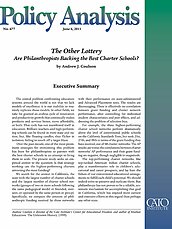Over the past decade, one of the most prominent strategies for overcoming this problem has been for philanthropists to partner with the best charter schools in an attempt to bring them to scale. The present study seeks an empirical answer to the question: Is that strategy working — are the highest-performing charters attracting the most funding?
We search for the answer in California, the state with the largest number of charter schools and the largest number of charter school networks (groups of two or more schools following the same pedagogical model or founded, overseen, or operated by the same person or group).
Specifically, we compare the amount of philanthropic funding received by these networks with their performance on state-administered and Advanced Placement tests. The results are discouraging. There is effectively no correlation between grant funding and charter network performance, after controlling for individual student characteristics and peer effects, and addressing the problem of selection bias.
For example, the three highest-performing charter school networks perform dramatically above the level of conventional public schools on the California Standards Tests, but rank 21st, 27th, and 39th in terms of the grant funding they have received, out of 68 charter networks. The AP results are worse; the correlations between charter networks’ AP performance and their grant funding are negative, though negligible in magnitude.
The top-performing charter networks, like top-ranked American Indian charter schools, play a transformative role in children’s educational and career prospects, and lay bare the failure of our conventional educational arrangements to fulfill each child’s potential. We should indeed strive to preserve and replicate them. But philanthropy has not proven to be a reliable, systematic mechanism for accomplishing that goal in California, which has enjoyed more earnest and extensive efforts in this regard than perhaps any other state.


